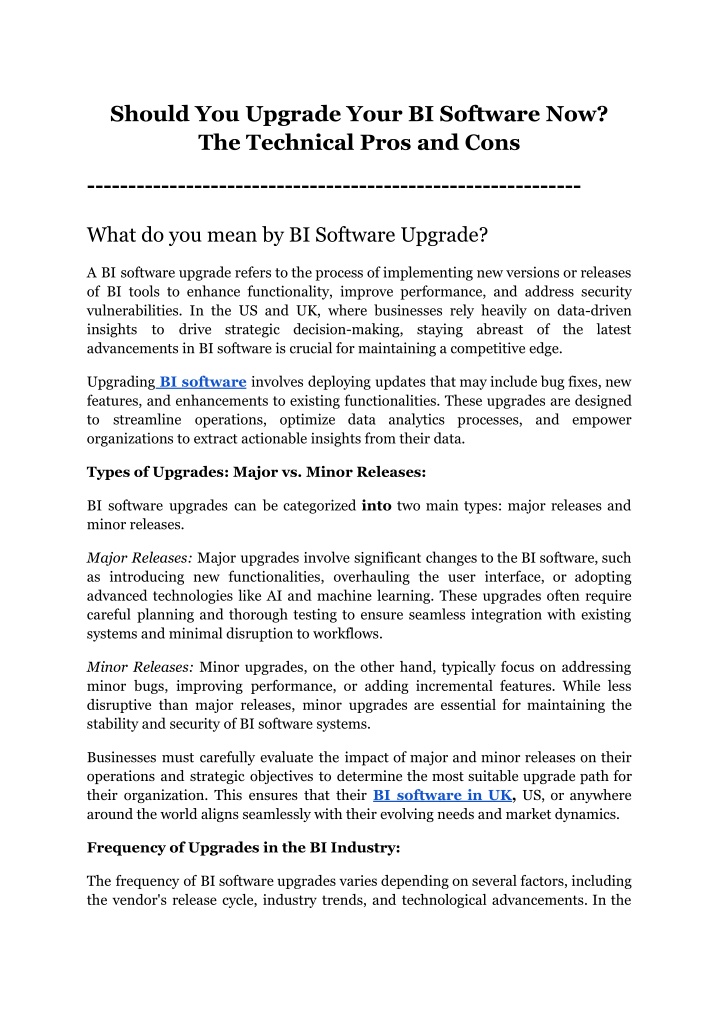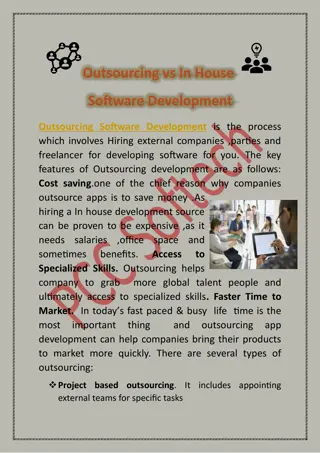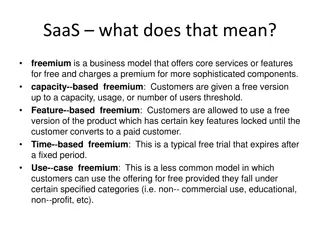
Should You Upgrade Your BI Software Now_ The Technical Pros and Cons
Discover the essential insights you need to make an informed decision about upgrading your BI software in UK, US, or globally. Delve into the technical pros and cons of upgrading BI software, tailored for business users, data analysts, and BI professionals. Explore the benefits of enhanced performance, advanced features, and better security measures, balanced against potential challenges such as compatibility issues, workflow disruptions, and cost considerations.
Download Presentation

Please find below an Image/Link to download the presentation.
The content on the website is provided AS IS for your information and personal use only. It may not be sold, licensed, or shared on other websites without obtaining consent from the author. If you encounter any issues during the download, it is possible that the publisher has removed the file from their server.
You are allowed to download the files provided on this website for personal or commercial use, subject to the condition that they are used lawfully. All files are the property of their respective owners.
The content on the website is provided AS IS for your information and personal use only. It may not be sold, licensed, or shared on other websites without obtaining consent from the author.
E N D
Presentation Transcript
Should You Upgrade Your BI Software Now? The Technical Pros and Cons ------------------------------------------------------------ What do you mean by BI Software Upgrade? A BI software upgrade refers to the process of implementing new versions or releases of BI tools to enhance functionality, improve performance, and address security vulnerabilities. In the US and UK, where businesses rely heavily on data-driven insights to drive strategic decision-making, advancements in BI software is crucial for maintaining a competitive edge. staying abreast of the latest Upgrading BI software involves deploying updates that may include bug fixes, new features, and enhancements to existing functionalities. These upgrades are designed to streamline operations, optimize data analytics processes, and empower organizations to extract actionable insights from their data. Types of Upgrades: Major vs. Minor Releases: BI software upgrades can be categorized into two main types: major releases and minor releases. Major Releases: Major upgrades involve significant changes to the BI software, such as introducing new functionalities, overhauling the user interface, or adopting advanced technologies like AI and machine learning. These upgrades often require careful planning and thorough testing to ensure seamless integration with existing systems and minimal disruption to workflows. Minor Releases: Minor upgrades, on the other hand, typically focus on addressing minor bugs, improving performance, or adding incremental features. While less disruptive than major releases, minor upgrades are essential for maintaining the stability and security of BI software systems. Businesses must carefully evaluate the impact of major and minor releases on their operations and strategic objectives to determine the most suitable upgrade path for their organization. This ensures that their BI software in UK, US, or anywhere around the world aligns seamlessly with their evolving needs and market dynamics. Frequency of Upgrades in the BI Industry: The frequency of BI software upgrades varies depending on several factors, including the vendor's release cycle, industry trends, and technological advancements. In the
rapidly evolving BI industry, software vendors continually strive to stay ahead of the competition by releasing regular updates and enhancements to their products. Major upgrades may occur annually or biannually, while minor updates are often released more frequently, ranging from monthly to quarterly intervals. The frequency of upgrades underscores the dynamic nature of the BI landscape, where innovation and agility are paramount. For businesses, staying informed about the frequency of BI software upgrades is essential for maximizing the value of their investment and leveraging the latest advancements in data analytics technology. The Technical Pros of Upgrading BI Software: Upgrading BI software holds significant advantages for businesses in the UK and US, enabling them to unlock enhanced performance, access advanced features and functionality, and bolster security measures. Let's delve into the technical benefits of upgrading BI software to understand how it can drive innovation and efficiency in data analytics processes. A. Enhanced Performance: 1. Use of Latest Technologies for Faster Processing: Upgrading BI software allows businesses to harness the power of the latest technologies, such as in-memory computing and parallel processing, to accelerate data processing speed. By leveraging these advancements, organizations can analyze vast datasets in real time, enabling faster decision-making and improved operational efficiency. For businesses seeking the best data dashboard software globally, embracing cutting-edge technologies through BI software upgrades is essential for staying competitive in a rapidly evolving market landscape. 2. Improved Scalability to Handle Larger Datasets: With the exponential growth of data volumes, scalability has become a critical consideration for BI software. Upgrading to the latest BI solutions empowers businesses to seamlessly scale their analytics infrastructure to accommodate ever-expanding datasets. Whether you're a small startup or a large enterprise, the ability to scale your BI software ensures that you can efficiently analyze data without being constrained by storage limitations or performance bottlenecks. This scalability is particularly crucial for businesses operating in dynamic industries or experiencing rapid growth. B. Advanced Features and Functionality:
1. Introduction of New Analytical Tools for Deeper Insights: One of the key advantages of upgrading BI software is gaining access to a wealth of new analytical tools and functionalities. From predictive analytics to advanced data visualization techniques, the latest BI solutions offer a plethora of capabilities for extracting deeper insights from your data. By leveraging these advanced features, businesses can uncover hidden patterns, trends, and correlations within their data, enabling them to make more informed decisions and drive strategic initiatives. 2. Integration with Emerging Technologies like AI and ML: BI software upgrades often include seamless integration with emerging technologies such as Artificial Intelligence (AI) and Machine Learning (ML). These technologies enable businesses to automate repetitive tasks, uncover actionable insights, and optimize decision-making processes. By harnessing the power of AI and ML, businesses can enhance the accuracy and efficiency of their data analytics workflows, leading to improved business outcomes and competitive advantage in the international market. C. Better Security Measures: 1. Patching Vulnerabilities to Prevent Data Breaches: Security is a top priority for businesses, especially when dealing with sensitive data. Upgrading BI software ensures that any known vulnerabilities or security loopholes are promptly patched, minimizing the risk of data breaches and cyber-attacks. With regulatory bodies imposing stricter data protection regulations, such as GDPR compliance, upgrading BI software is essential for ensuring data security and maintaining regulatory compliance. 2. Compliance with Evolving Regulatory Standards: Regulatory standards pertaining to data privacy and security are constantly evolving. BI software upgrades include updates to ensure compliance with the latest regulatory requirements, enabling businesses to mitigate legal risks and uphold their reputation. By staying ahead of regulatory changes through regular BI software upgrades, businesses can demonstrate their commitment to data protection and earn the trust of customers and stakeholders. The Technical Cons of Upgrading BI Software: While upgrading BI software offers numerous benefits, it also comes with its fair share of technical challenges that businesses must navigate. Understanding these cons is crucial for making informed decisions and mitigating potential risks associated with the upgrade process. Let's delve into the technical drawbacks of upgrading BI software to gain a comprehensive understanding.
A. Compatibility Issues: 1. Potential Conflicts with Existing Systems and Databases: One of the primary concerns when upgrading BI software is the potential for compatibility issues with existing systems and databases. Incompatibilities between the upgraded software and legacy systems can lead to data integration challenges, functionality issues, and disruptions to business operations. For businesses relying on the best data dashboard software in the UK, US and other places, ensuring seamless compatibility with existing infrastructure is paramount for maintaining continuity and maximizing ROI from the upgrade. 2. Need for Extensive Testing Before Full Deployment: To mitigate compatibility issues and ensure a smooth transition, extensive testing is required before fully deploying the upgraded BI software. Testing involves validating the functionality, performance, and compatibility of the new software across different environments and use cases. While thorough testing is essential for identifying and resolving potential issues, it can prolong the upgrade process and require significant resources in terms of time and manpower. B. Disruption to Workflow: 1. Downtime During the Upgrade Process Impacting Productivity: Upgrading BI software often entails downtime during the upgrade process, which can disrupt business operations and impact productivity. Downtime may result from system maintenance, data migration, or configuration changes required to implement the new software. For businesses, minimizing downtime is critical for maintaining operational efficiency and ensuring the continuity of essential business functions. Proper planning and coordination are necessary to minimize the impact of downtime on workflow. 2. Training Required for Users to Adapt to Changes: Introducing new BI software may necessitate training for users to adapt to changes in workflows, features, and interfaces. Without adequate training, employees may struggle to leverage the full capabilities of the upgraded software, leading to inefficiencies and reduced productivity. Investing in comprehensive training programs tailored to the specific needs of users can help accelerate the adoption of the new BI software and maximize its value for the organization. C. Cost Considerations: 1. Licensing Fees for Upgraded Versions: Upgrading BI software often incurs additional costs in the form of licensing fees for upgraded versions. While the
benefits of the upgrade may justify the investment, businesses must carefully evaluate the total cost of ownership and weigh it against the anticipated benefits. For businesses, seeking to optimize their budget allocation for BI initiatives, understanding the licensing model and negotiating favorable terms with software vendors is essential for cost-effective implementation. 2. Investment in Hardware Upgrades to Support New Features: Upgrading to the latest BI software may necessitate investment in hardware upgrades to support new features and functionalities. Hardware requirements may include additional storage capacity, processing power, or memory to accommodate the increased demands of the upgraded software. Businesses must factor in the cost of hardware upgrades when budgeting for BI software upgrades and ensure alignment with their overall IT infrastructure strategy. Evaluating the Decision to Upgrade: Deciding whether to upgrade BI software is a critical decision that requires careful consideration of various factors, including the current state of your BI infrastructure, the potential benefits and drawbacks of the upgrade, and its long-term impact on ROI and business objectives. Let's explore each aspect in detail to help you make an informed decision tailored to your business needs. A. Assessing the Current State of Your BI Infrastructure: Before going on an upgrade journey, it's essential to assess the current state of your BI infrastructure. This involves evaluating the performance, functionality, and scalability of your existing BI software to identify any shortcomings or areas for improvement. Consider factors such as data processing speed, user satisfaction, and the ability to handle growing datasets. Are there any bottlenecks or limitations hindering your ability to derive actionable insights from your data? Understanding the strengths and weaknesses of your current BI infrastructure is the first step toward determining whether an upgrade is necessary. For businesses in the global markets relying on the best data dashboard software, conducting a comprehensive assessment of their BI infrastructure is crucial for ensuring alignment with evolving business needs and industry standards. B. Weighing the Benefits Against the Drawbacks: Once you've assessed the current state of your BI infrastructure, it's time to weigh the potential benefits of upgrading against the associated drawbacks. Consider the technical pros and cons we've discussed earlier, such as enhanced performance, advanced features, compatibility issues, and downtime.
Evaluate how the anticipated benefits of upgrading, such as improved analytics capabilities and enhanced security measures, align with your business objectives and strategic priorities. Conversely, consider the potential drawbacks, such as disruption to workflow and additional costs, and assess their impact on your organization. For businesses contemplating an upgrade, conducting a comprehensive cost-benefit analysis is essential for making a well-informed decision that maximizes ROI and minimizes risks. C. Considering Long-Term ROI and Business Objectives: Beyond immediate benefits and drawbacks, it's essential to consider the long-term implications of upgrading BI software on ROI and business objectives. Evaluate how the upgrade aligns with your long-term strategic goals, such as increasing operational efficiency, driving revenue growth, or enhancing customer satisfaction. Consider the potential impact of the upgrade on key performance indicators (KPIs) such as productivity, profitability, and customer retention. Will the upgraded BI software enable you to achieve your business objectives more effectively than your current infrastructure?
Also, consider the scalability and flexibility of the upgraded BI software to support future growth and innovation. Will it adapt to evolving business needs and technological advancements in the UK market? By considering long-term ROI and business objectives, businesses can make strategic decisions that not only optimize short-term benefits but also position them for sustained success and competitive advantage in the dynamic landscape of BI software in UK. Conclusion At the end of the day, the decision to upgrade your BI software is a strategic one that requires careful consideration of the technical pros and cons, as well as alignment with your business objectives. As we've explored, upgrading BI software offers numerous benefits, including enhanced performance, advanced features, and better security measures. However, it also comes with potential challenges such as compatibility issues, disruption to workflow, and cost considerations. At Grow, we understand the complexities involved in upgrading BI software, and we're here to support you every step of the way. Our comprehensive BI solutions are designed to empower businesses in the UK, US, and other countries to unlock the full potential of their data and drive informed decision-making. Whether you're looking to enhance performance, access advanced analytics tools, or ensure compliance with regulatory standards, Grow has you covered. Take advantage of our 14-day free trial to experience the transformative power of our BI software firsthand. With Grow, you can optimize your data analytics processes, maximize ROI, and stay ahead of the competition in today's rapidly evolving business landscape. Ready to take the next step? Sign up for our 14-day free trial today and discover why Grow is the preferred choice for businesses seeking the best data dashboard software in the UK. You can also check out the latest Grow Pricing 2024 on Capterra to find the perfect plan that fits your budget and business needs. Upgrade your BI software with Grow and unlock a world of possibilities for your business.






















